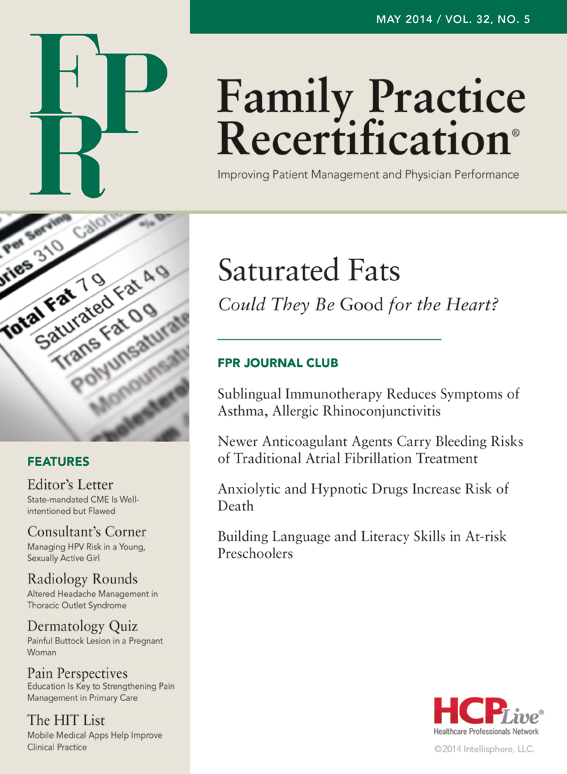Sublingual Immunotherapy Reduces Symptoms of Asthma, Allergic Rhinoconjunctivitis
With the US Food and Drug Administration's recent approval of 2 sublingual immunotherapies for allergic rhinitis with or without conjunctivitis, US physicians no longer have to pursue the off-label use of these treatments.
Review
Lin SY, et al. Sublingual immunotherapy for the treatment of allergic rhinoconjunctivitis and asthma: a systematic review. JAMA. 2013:309(12):1278-88. http://www.ncbi.nlm.nih.gov/pubmed/23532243.
Study Methods
This systematic review examined the use of sublingual immunotherapy (SLIT) for allergic rhinoconjunctivitus and asthma in English-language studies searched throughout MEDLINE, EMBASE, and LILACS databases and the Cochrane Central Register of Controlled Trials through December 22, 2012. All of the studies were evaluated based on their risk of bias and strength of evidence.
Patient Demographics
Among the 63 studies included in the review, there were a total of 5,131 participants aged 4-74 years old; 20 of the studies (32%) only included children aged <18 years, while 26 studies (41%) only enrolled adults. Each participant underwent airborne allergen confirmation via skin testing or immunoglobulin E (IgE) blood testing, which revealed that grass mix and dust mites were the most commonly occurring allergens in the study population.
Results and Outcomes
In 9 of the 13 studies (69%) evaluating the efficacy of SLIT in asthma, there was a >40% decrease in asthma symptoms compared to placebo, conventional pharmacology, or other immunotherapy regimens. Thus, the authors determined there was high-grade evidence to support SLIT for asthma symptom improvement.
Similarly, 94% of the 36 studies evaluating the efficacy of SLIT in allergic rhinoconjunctivitus showed improvement over the comparator treatment, while 39% showed a moderate or strong magnitude of change. Therefore, the authors determined there was moderate-grade evidence to support the use of SLIT to improve allergic rhinoconjunctivitus symptoms.
Additionally, the authors found moderate-grade evidence regarding the use of SLIT for conjunctivitis symptom relief, decreased medication use, and improved disease-specific quality of life. Among the studies that included only pediatric patients, the use of SLIT was supported in both asthma and allergic rhinoconjunctivitus with moderate-grade evidence.
Although adverse event reporting was unstandardized and incomplete, it did reveal local reactions were more common with SLIT compared to placebo or conventional pharmacotherapy. However, no anaphylaxis or life-threatening reactions were reported with SLIT use.
Conclusion
Moderate-grade evidence supports the effectiveness of SLIT in treating symptoms of allergic rhinoconjunctivitus and asthma, but further study is needed to determine the therapy’s ideal dosing regimen and efficacy compared to conventional treatments.
Commentary
SLIT has been praised for its comparative ease of administration, and in some parts of Europe, it represents up to 85% of the allergen-specific immunotherapy used for the treatment of symptoms related to airborne allergens.
This systematic review presented a strong case for the efficacy and safety of SLIT in allergic rhinitis and even asthma symptoms. Specific strengths of the study included its long timeframe, rigorous bias risk assessment, and standardized assessment of evidence strength, in addition to its wide participant age range, varied airborne allergens, and extensive geographic location that contribute to the external validity of the results.
Although the study’s largest limitation was its lack of a dosing analysis, the authors cited a wide heterogeneity of dosing regimens. In particular, they pointed out that dosing frequency alone varied daily to weekly, with dosages in different, incomparable units. Despite determining SLIT was efficacious for symptom relief of asthma and allergic rhinoconjunctivitus and discovering moderate evidence to support its use in those conditions, the authors did not provide an ideal dosing amount and frequency; instead, they merely stated the need for further study of dosing requirements.
Another limitation of this review was the incomplete reporting of safety and adverse events in the included trials. However, this might be of little importance, since no life-threatening reactions or anaphylaxis were reported with administration of SLIT.
Within the past month, the US Food and Drug Administration (FDA) has approved 2 SLIT medications for patients with allergic rhinoconjunctivitus. The first, Oralair, is specific for a mix of 5 grass pollens and approved for use in patients aged 10-65 years. Although the first dose must be administered by a healthcare provider to monitor for serious reactions, subsequent daily doses can be administered at home. Oralair’s efficacy trials showed a 16-30% reduction in symptoms and medication use following administration, and the most commonly reported adverse reactions were throat irritation and swelling of the mouth.
The more recently approved SLIT, Grastek, is specific for Timothy grass pollen and approved for use in patients aged 5 years and older. Similar to Oralair, it is a daily medication with an initial dose administered in the healthcare provider’s office 8-12 weeks prior to the pollen season.
Nevertheless, the appropriate candidates for these interventions and the therapies that can be combined with SLIT still need to be determined. Logically, it makes sense to use these agents in those who are not well controlled on current medications during the allergy season. Perhaps, these patients should begin SLIT 4 months prior to their symptomatic period, and then add in supporting treatments on an as-needed basis.
With the FDA’s approval of 2 SLITs for allergic rhinitis with or without conjunctivitis, US physicians no longer have to pursue the off-label use of this treatment. As this systematic review discussed, there is moderate-grade evidence to support the use of SLIT for symptom relief without fear of severe adverse events. Although SLIT is administered more frequently than subcutaneous immunotherapy (SCIT), its ease of administration through ingestion makes it a particularly attractive option for many patient populations, especially children.
About the Authors
Amanda Bernier, MD, is a recent graduate of the University of Massachusetts Medical School in Worcester, MA.
She was assisted in writing this article by Frank J. Domino, MD, Professor and Pre-Doctoral Education Director for the Department of Family Medicine and Community Health at the University of Massachusetts Medical School and Editor-in-Chief of the 5-Minute Clinical Consult series (Lippincott Williams & Wilkins).
